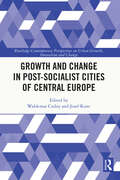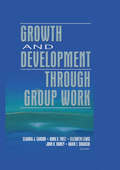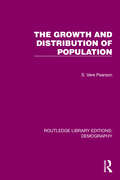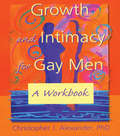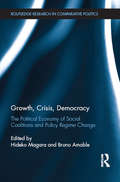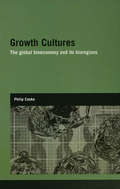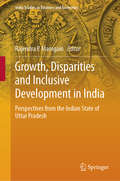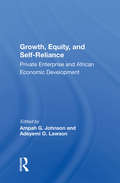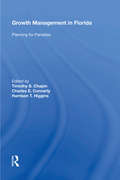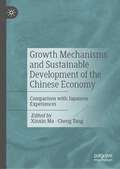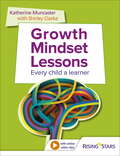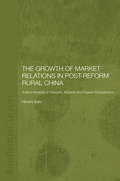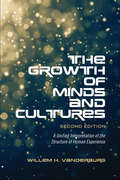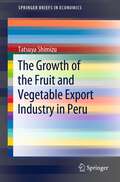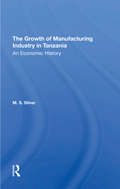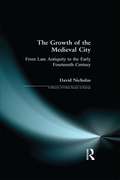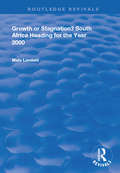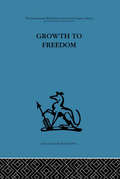- Table View
- List View
Grown-Up Anger: The Connected Mysteries of Bob Dylan, Woody Guthrie, and the Calumet Massacre of 1913
by Daniel WolffA brilliantly intertwined account of two revolutionary musicians, a miners’ strike, and a deadly tragedy: “Reads like a historical detective story.” —The New York Times Book ReviewAt thirteen, when he first heard Bob Dylan’s “Like a Rolling Stone,” Daniel Wolff recognized the sound of anger. When he later discovered “Song for Woody,” Dylan’s tribute to folk musician Woody Guthrie, Wolff fixed on it as a clue to a distinctive mix of rage and compassion. That clue led back to Guthrie’s “1913 Massacre”—a memorial song about the horrific conclusion to a union Christmas party in Calumet, Michigan.Following the trail from Dylan to Guthrie to a tragedy that claimed seventy-four lives, Wolff found himself tracing a century-long line of anger. From America’s early industrialized days up to the present, the battle over economic justice keeps resurfacing: on a freight car in California, on a joyride through New Orleans, in a snowy field in Michigan. At the stunning conclusion—as the mysteries of Dylan, Guthrie, and the 1913 tragedy connect—the reader discovers a larger story, purposely distorted and buried in time.A tour de force of storytelling years in the making that chronicles the struggles between the haves and have-nots, Grown-Up Anger is both a dual biography of two legendary songwriters and a murder mystery. It also serves as a history of labor relations and socialism, big business and greed in twentieth-century America—all woven together in one epic saga.“A fascinating and relevant whirlwind examination of music, economic injustice, and two American icons.” —Booklist (starred review)“A masterful tale of music, social, and economic history . . . A dazzling, richly researched story impeccably told.” —Kirkus Reviews (starred review)
Growth and Capital Flows with Risky Entrepreneurship
by Damiano SandriA report from the International Monetary Fund.
Growth and Change in Post-socialist Cities of Central Europe (Routledge Contemporary Perspectives on Urban Growth, Innovation and Change)
by Cudny Waldemar Kunc JosefThis book presents multidimensional socio-economic transformations taking place in the post-socialist cities located in selected countries of the Central European region. The analysis includes case studies from the Eastern part of Germany (Chemnitz, Leipzig), Poland (Łódź, Kielce, Katowice conurbation, and peripheral urban centres from Eastern Poland), Slovakia (Bratislava, Nitra), the Czech Republic (Olomouc, Brno), and from Hungary (Pécs). The analysed urban areas have undergone far-reaching political and socio-economic changes in the last 30 years. These changes began with the collapse of communism and the centrally planned economy system in the region of Central Europe. The beginning of this period, often referred to as post-socialist transformation, dates back to 1989. The consequence of the aforementioned political processes was the multifaceted socio-economic and demographic changes that significantly affected urban areas in Central Europe. This book presents an attempt to summarize the main long-term processes of changes taking place in these urban areas and to identify contemporary and future trends in their socio-economic development. The book will be valuable to undergraduate and postgraduate students in human geography, urban studies, economy, and city marketing, especially with an interest in Central Europe.
Growth and Development Through Group Work
by Elizabeth Lewis Claudia Carson Anna FritzExamine group work's roots and fundamental beliefs to get a glimpse of the future For more than 80 years, social group work has survived difficult times-a testament to the persistence of its practitioners as well as the strength of its methods. Growth and Development Through Group Work chronicles the evolution of this groundbreaking practice through a collection of peer-reviewed papers presented at the 23rd Annual International Symposium on Social Work with Groups. The book examines practice, policy, and education issues in specific settings and populations from both theoretical and historical perspectives. Presented in the wake of the September 11 terrorist attacks in New York City and Washington, DC, the papers that comprise Growth and Development Through Group Work reflect a heightened awareness of the importance of social action group work-now, and in the future. The book represents the best of social work&’s tradition of social reform and concern for oppressed people, never straying far from the concept of the group, with its multiple helping relationships, as the primary source of change. A comprehensive overview of the field in international, intercultural, and cross-gender contexts, Growth and Development Through Group Work is equally effective for coursework or independent reading. Topics addressed in Growth and Development Through Group Work include: contributions of the late Ruby B. Pernell to the development of social group work research in support of group work education and practice group work in Germany-its development from American roots and its current advances social justice as a major objective of group work practice teaching group work mutual aid in support groups for particularly sensitive health problems psychoeducational group work contributions from Hull House as guides for the future of social group workGrowth and Development Through Group Work is an invaluable resource for clinicians, neighborhood and community activists, educators and students, researchers, therapists, administrators, and anyone working in policy and/or program development.
The Growth and Distribution of Population (Routledge Library Editions: Demography #10)
by S. Vere PearsonOriginally published in 1935, this book examines the causes of global rural depopulation, slum housing conditions and city over-crowding. The falling birth-rate in the West, town planning, ribbon development, emigration and traffic problems are also discussed with particular focus on how they affect the growth and distribution of populations. Social, psychological and economic factors are all considered, as well as those dependent on physical geography.
Growth and Intimacy for Gay Men: A Workbook
by Christopher J AlexanderGrowth and Intimacy for Gay Men: A Workbook is an educational workbook for gay men that covers a variety of topics, including family of origin, addiction, self-image, dating and relationships, AIDS and multiple loss, and spirituality. Each chapter provides an overview of the mental health concerns of gay men, as well as exercises the reader can do to facilitate his personal understanding of the issues covered. While the book is written in nontechnical language, making it useful to the general public, its wide selection of workbook exercises makes it useful for psychotherapists and counselors working with gay men. Growth and Intimacy for Gay Men is written to the reader--with brief examples from the author’s work as a clinical psychologist helping gay men. A central goal of the book is to normalize the feelings and experiences the reader has, as many gay men feel like they’re the only ones with their feelings or experiences. The book’s problem-solving approach addresses: family of origin--provides exercises to identify and examine gay men’s role in the family, examine their childhood perceptions of being different, and help them map out family patterns and dynamics self-image--includes self-image assessment questionnaires and written exercises that challenge the reader to look at how they’re affected by societal perceptions addiction--explores why gay men are vulnerable to addictive behavior and offers strategies for change and self-assessment exercises dating and relationships--covers the unique challenges faced by gay men, with exercises for single as well as coupled men AIDS and mental health--provides exercises to help the reader examine the impact of AIDS on his own life and to assess the impact of multiple loss and prolonged grief Readers can do the workbook exercises on their own, or therapists can assign chapters and exercises as homework, with clients bringing the completed assignment to therapy for more in-depth exploration and discussion. By providing informative chapters and useful exercises, Growth and Intimacy for Gay Men becomes an avenue through which gay men can understand their identity, experiences, and goals.
Growth and Intimacy for Gay Men: A Workbook
by Christopher J. AlexanderGrowth and Intimacy for Gay Men: A Workbook is an educational workbook for gay men that covers a variety of topics, including family of origin, addiction, self-image, dating and relationships, AIDS and multiple loss, and spirituality. Each chapter provides an overview of the mental health concerns of gay men, as well as exercises the reader can do to facilitate his personal understanding of the issues covered. While the book is written in nontechnical language, making it useful to the general public, its wide selection of workbook exercises makes it useful for psychotherapists and counselors working with gay men.
Growth, Crisis, Democracy: The Political Economy of Social Coalitions and Policy Regime Change (Routledge Research in Comparative Politics)
by Hideko Magara and Bruno AmableSince the global financial crisis of 2008, advanced economies have been making various efforts to overcome the economic impasse. While the contrast between the countries that have escaped from the crisis relatively quickly and those still suffering from serious problems is becoming clearer, a new economic crisis stemming from newly emerging economies has again impacted advanced economies. In retrospect, both leftist and rightist governments in advanced economies pursued expansive macroeconomic and welfare policies from the post-WWII period to the oil shocks of the 1970s. While we recognise that the particular policy regime in this ‘Golden Decades’ during which the left and the right implemented similar policies cross-nationally, were characterised by outstanding economic growth in each country, the specific growth patterns varied across countries. Different social coalitions underpinned different growth models. This book is premised on tentative conclusions that Magara and her research collaborators have reached as a result of three years of study related to our previous project on economic crises and policy regimes. Recognising the need to analyse fluid and unstable situations, we have set up a new research design in which we emphasise political variables—whether political leaders and citizens can overcome the various weaknesses inherent in democracy and escape from an economic crisis by establishing an effective social coalition. A new policy regime can be stable only if it is supported by a sufficiently large coalition of social groups whose most important policy demands are satisfied within the new policy regime.
Growth Cultures: The Global Bioeconomy and its Bioregions (Genetics And Society Ser.)
by Philip CookeThis groundbreaking book is the first comparative analysis of the relative strengths of global bioregions. Growth Cultures investigates the rapidly growing phenomena of biotechnology and sets this study within a knowledge economy context. Philip Cooke proposes a new knowledge-focused theoretical framework, ‘the New Global Bioeconomy’, against which to test empirical characteristics of biotechnology. In this timely volume, Cooke unifies concepts from the sociology of science, economic sociology and evolutionary economic geography to focus on the problems and prospects for policy agencies worldwide trying to build ‘biotechnology clusters’. He develops a superior policy approach of thinking in terms of platforms that integrate proximities and pipelines, which will be of significant interest for the scientific and technological communities as well as economic development policy communities. Growth Cultures will make fascinating reading for students, policy makers and researchers across management and business studies, innovation and knowledge studies, sociology, science and technology policy, applied economics, development studies and regional science.
Growth, Disparities and Inclusive Development in India: Perspectives from the Indian State of Uttar Pradesh (India Studies in Business and Economics)
by Rajendra P. MamgainThe book critically examines the high growth trajectory in India, particularly since the late 1980s, a period which is characterized by increasing inequality. Through various studies from the Indian state of Uttar Pradesh -- a state more populous than Brazil and with a GDP comparable to Bangladesh -- it sheds light on the link between growth and inequality in emerging economies. The slow pace of any upward movement in terms of various development indicators in low-income Indian states is due to a number of factors, including their historical disadvantages. Over a period of time, this has resulted in widening disparities, both between different regions of these states, and between these states and other more prosperous Indian states.The book provides a holistic, yet critical, region-wise analysis of the achievements of Uttar Pradesh compared to other states and to India as a whole, in the context of indicators of inclusive development, namely, growth, employment, poverty, infrastructure, agriculture, industry, education and health. Based on the latest data and sophisticated analysis methods, it assesses inequality and development disparities, clearly identifying three major challenges that poorer states face in redressing poverty and expanding inclusive growth – increasing economic opportunities, empowering poor and marginalised groups to avail new opportunities in a rapidly changing world, and ensuring an effective safety net to reduce vulnerability.The book suggests strategies for promoting high and sustained economic growth, and highlights the significance of broadening social inclusiveness through greater and more rapid access to economic and social opportunities, and building strong social safety nets to protect the chronically poor and mitigate their risks and vulnerabilities with the help of good governance and institutions. With contributions from leading scholars from the region, it is a valuable resource for researchers working in the area of growth and inequality, as well as for policy makers from developing economies around the globe.
Growth, Equity, And Self-reliance: Private Enterprise And African Economic Development
by Ampah G. Johnson Adeyemi O. LawsonThis book explores what is, for many African countries, a new and controversial policy of relying on private actors rather than on government organizations to foster economic growth and development. The contributors explore key issues such as the impact of private enterprise on the development process, small- and medium-sized businesses as a vehicle for growth, and strategies for the expansion of markets and trade. The contributors analyze the historical, social, cultural, and economic obstacles to the development of private enterprise in Africa; the roles of government, women, and business organizations; access to capital and the function of financial institutions; private initiative and agriculture; the use of skilled and semi-skilled labor; and technology transfer. Arguing that private sector forces are crucial to African socioeconomic development, the contributors recommend economic policy reform, establishment of more private enterprises, and encouragement of new domestic and foreign investment.
Growth in Ghana: A Macroeconometric Model Simulation Integrating Agriculture (Routledge Revivals)
by Daniel Bruce SarpongPublished in 1997, this text is set in a context where Ghana has experienced improvements in aggregate output performance over the past decade (1986-1996) yet agriculture's performance remains sub-optimal. The author focuses on agriculture's fragmentation as attributable to space (storage, transportation and marketing), form (rudimentary production methods in general) and content (stagnent productivity and poor organization of production) and notes that whilst current policies have impinged on the space fragmentation, issues on form and content seem to have been left to the dictates of the market. The author calls for a strategy of government plan in promoting modern technology in agriculture to enhance its linkage to industry for rapid and sustainable economic growth.
Growth Management in Florida: Planning for Paradise (Urban Planning And Environment Ser.)
by Timothy S.ChapinDespite its historical significance and its state-mandated comprehensive planning approach, the Florida growth management experiment has received only piecemeal attention from researchers. Drawing together contributions from national experts on land use planning and growth management, this volume assesses the outcomes of Florida‘s approach for managing growth. As Florida‘s approach is the most detailed system for managing growth in the United States, this book will be of great value to planners. The strengths and weaknesses of the state‘s approach are identified, providing insights into how to manage land use change in a state continuously inundated by growth. In evaluating the successes and failures of the Florida approach, planners and policy makers will gain insights into how to successfully implement growth management policies at both the state and local level.
Growth Mechanisms and Sustainable Development of the Chinese Economy: Comparison with Japanese Experiences
by Xinxin Ma Cheng TangWhat can Chinese economists learn from the Japanese economic boom and subsequent stagnation? This project aims to institutionally and empirically investigate the growth mechanism and determinants of sustainable development in China compared with Japanese experiences. This is the first challenge in conducting a comparative study on China and Japan’s economic growth and development. We aim to investigate the economic system transition and its influence on the Chinese and Japanese economy from macroeconomic and microeconomic perspectives. This book will interest economists, scholars of comparative politics, and scholars of China or Japan's economic development.
Growth Mindset Lessons: Every Child a Learner
by Shirley Clarke Katherine MuncasterPractising teacher and mindset expert Katherine Muncaster has combined with best-selling author Shirley Clarke to produce this 'must-have' handbook for anyone looking to embed a growth mindset culture across their primary school. With practical strategies, lesson plans and extensive examples and realia in full colour, this comprehensive resource takes the concept of growth mindset and turns it into a powerful reality. · A comprehensive and practical scheme of work which will develop a powerful learning culture throughout your school· A tangible way to put growth mindset into action which has been developed, tested and trialled by Katherine Muncaster· Co-authored by leading professional development expert Shirley Clarke· Supported by easy-to-access classroom video clips that provide demonstrations of the impact of this approach in lessons.
Growth Mindset Lessons: Every Child a Learner
by Shirley Clarke Katherine MuncasterPractising teacher and mindset expert Katherine Muncaster has combined with best-selling author Shirley Clarke to produce this 'must-have' handbook for anyone looking to embed a growth mindset culture across their primary school. With practical strategies, lesson plans and extensive examples and realia in full colour, this comprehensive resource takes the concept of growth mindset and turns it into a powerful reality. · A comprehensive and practical scheme of work which will develop a powerful learning culture throughout your school· A tangible way to put growth mindset into action which has been developed, tested and trialled by Katherine Muncaster· Co-authored by leading professional development expert Shirley Clarke· Supported by easy-to-access classroom video clips that provide demonstrations of the impact of this approach in lessons.
The Growth of Incarceration in the United States
by Committee on Causes Consequences of High Rates of IncarcerationAfter decades of stability from the 1920s to the early 1970s, the rate of imprisonment in the United States has increased fivefold during the last four decades. The U. S. penal population of 2. 2 million adults is by far the largest in the world. Just under one-quarter of the world's prisoners are held in American prisons. The U. S. rate of incarceration, with nearly 1 out of every 100 adults in prison or jail, is 5 to 10 times higher than the rates in Western Europe and other democracies. The U. S. prison population is largely drawn from the most disadvantaged part of the nation's population: mostly men under age 40, disproportionately minority, and poorly educated. Prisoners often carry additional deficits of drug and alcohol addictions, mental and physical illnesses, and lack of work preparation or experience. The growth of incarceration in the United States during four decades has prompted numerous critiques and a growing body of scientific knowledge about what prompted the rise and what its consequences have been for the people imprisoned, their families and communities, and for U. S. society. The Growth of Incarceration in the United States examines research and analysis of the dramatic rise of incarceration rates and its affects. This study makes the case that the United States has gone far past the point where the numbers of people in prison can be justified by social benefits and has reached a level where these high rates of incarceration themselves constitute a source of injustice and social harm. The Growth of Incarceration in the United States examines policy changes that created an increasingly punitive political climate and offers specific policy advice in sentencing policy, prison policy, and social policy. The report also identifies important research questions that must be answered to provide a firmer basis for policy. This report is a call for change in the way society views criminals, punishment, and prison. This landmark study assesses the evidence and its implications for public policy to inform an extensive and thoughtful public debate about and reconsideration of policies.
The Growth of Market Relations in Post-Reform Rural China: A Micro-Analysis of Peasants, Migrants and Peasant Entrepeneurs (Routledge Studies on the Chinese Economy)
by Hiroshi SatoThis book, based on in-depth field research at the local level, assesses the different factors that are contributing to the transition to a market economy and the growth of networks in rural China. It analyses the different socio-economic actors - peasant households, out-migrants, family businesses and peasant entrepreneurs, uses the key concept of markets as a nexus of social networks, and identifies three different kinds of 'social capital' - human capital, political capital/status, and network capital.This book demonstrates the importance of socio-political networks and highlights significant regional differences.
The Growth of Minds and Culture: A Unified Interpretation of the Structure of Human Experience
by Willem H. VanderburgThe impact of science and technology on culture raises a number of questions about the ways in which people relate to each other and to their environment. Such questions cannot be answered by traditional approaches. Thus another level of analysis is needed to complement the traditional approaches and to address future challenges. The first step in creating this new analysis was taken by Willem H. Vanderburg in 1985 with his pioneering work The Growth of Minds and Cultures. In this book, the first of a multi-volume series that includes Our Battle for the Human Spirit (2016), Vanderburg shows how the culture of a society underlies its science, technology, economy, social structure, political institutions, morality, religion, and art. As such, he seeks to build bridges not only between the ‘two cultures’ but between all the sciences in order to gain a deeper understanding of our age. This expanded second edition makes the author’s ground-breaking analysis available to a generation of digital natives.
The Growth of the Fruit and Vegetable Export Industry in Peru (SpringerBriefs in Economics)
by Tatsuya ShimizuThis is the first book that analyzes the growth of the Peruvian fresh fruit and vegetable (FFV) export industry from the view point of the industrial development. Instead of pointing out comparative advantages in production factors such as favorable climate and cheap labor, this book focuses on the strategies of agribusiness companies, industrial organizations, and the public sector in the FFV export industry. The analysis is based on the theoretical frameworks of coordination, integration, and upgrades in value chains, business strategies to overcome seasonality and mitigate risks in agriculture, and cluster development based on joint actions among players in the industry. Based on the field studies with major FFV production and export companies and industrial organizations, the case studies describe specific innovations in management and organizations taken by key actors in the industry. This book can help policymakers in developing countries seek industrial development options based on agricultural exports.
The Growth Of The Manufacturing Industry In Tanzania: An Economic History
by M. S. Silver M S SilverTracing the evolution of the Tanzanian manufacturing industry since the beginning of colonial rule, this book focuses on the period since independence and especially on the effects of socialist policies resulting from the 1967 Arusha Declaration. Dr. Silver develops volume indices of production for Tanzanian industry as a whole and for individual sectors. He also examines in detail changes in labor productivity, earnings, unit labor costs, investments, and the prices of manufactured goods, paying special attention to the role of government-controlled parastatals, the regional distribution of manufacturing industries, and income inequality. The rapid growth in production and employment and the changing structure of the manufacturing industry, he concludes, is due to high rates of investment in a small number of relatively large establishments, primarily in the parastatal sector.
The Growth of the Medieval City: From Late Antiquity to the Early Fourteenth Century (A History of Urban Society in Europe)
by David M NicholasThe first part of David Nicholas's massive two-volume study of the medieval city, this book is a major achievement in its own right. (It is also fully self-sufficient, though many readers will want to use it with its equally impressive sequel which is being published simultaneously.) In it, Professor Nicholas traces the slow regeneration of urban life in the early medieval period, showing where and how an urban tradition had survived from late antiquity, and when and why new urban communities began to form where there was no such continuity. He charts the different types and functions of the medieval city, its interdependence with the surrounding countryside, and its often fraught relations with secular authority. The book ends with the critical changes of the late thirteenth century that established an urban network that was strong enough to survive the plagues, famines and wars of the fourteenth and fifteenth centuries.
Growth or Stagnation?: South Africa Heading for the Year 2000 (Routledge Revivals)
by Mats LundahlFirst published in 1999, the essays collected in the present volume derive from an interest in South Africa and its economy which goes back to the early 1970s and were written between 1994 and 1999. The intention is to follow how the debate on the South African economy has evolved since the fall of the apartheid regime. Issues discussed include the South African economy after apartheid and whether the new South African economy is ultimately experienced growth or stagnation.
Growth to Freedom: The Psychosocial Treatment of Delinquent Youth
by Derek MillerTavistock Press was established as a co-operative venture between the Tavistock Institute and Routledge & Kegan Paul (RKP) in the 1950s to produce a series of major contributions across the social sciences. This volume is part of a 2001 reissue of a selection of those important works which have since gone out of print, or are difficult to locate. Published by Routledge, 112 volumes in total are being brought together under the name The International Behavioural and Social Sciences Library: Classics from the Tavistock Press. Reproduced here in facsimile, this volume was originally published in 1964 and is available individually. The collection is also available in a number of themed mini-sets of between 5 and 13 volumes, or as a complete collection.
Growth Triumphant
by Richard A. EasterlinTaking a longer view than most literature on economic development, Richard A. Easterlin stresses the enormous contrast between the collective experience of the last half century in both developed and developing countries and what has gone before. An economic historian and demographer, the author writes in the tradition of the "new economic history," drawing on economic theory and quantitative evidence to interpret the historical experience of economic theory and population growth. He reaches beyond the usual disciplinary limits to draw, as appropriate, on sociology, political science, psychology, anthropology, and the history of science. The book will be of interest not only to social scientists but to all readers concerned with where we have been and where we are going. ". . . Easterlin is both an economic historian and a demographer, and it is the combination of these two disciplines and the fine balance between theory and experience that make this well-written, refreshingly optimistic book excellent reading. " --Population and Development Review "In this masterful synthesis, Richard Easterlin draws on the disciplines of economic history, demography, sociology, political science, psychology, and the history of science to present an integrated explation of the origins of modern economic growth and of the mortality revolution. . . . His book should be easily accessible to non-specialists and will give them a sense of why economic history can inform our understanding of the future. " --Dora L. Costa, Massachusetts Institute of Technology, EH. Net and H-Net "Growth Triumphant is, simply, a fascinating book. Easterlin has woven together a history of economic growth, economic development, human mortality and morbidity, the connections each has with the others, and the implications of this nexus of forces on the future. . . . This book deserves a wide audience. " --Choice "In what must surely be the most fair-minded, well-balanced, and scrupulously reasoned and researched book on the sensational subjects implied in its title--the Industrial Revolution, the mortality and fertility revolutions, and the prospects for future happiness for the human race--Professor Easterlin has set in place the capstone of his research career. " --Journal of Economic History Richard A. Easterlin is Professor of Economics, University of Southern California.


